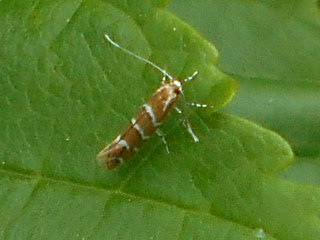I have been using the same SD card in my camera for several years now so, although it is still functioning, I am not sure that, in terms of colour, the pictures are as good as they could be. Results are particularly poor when dealing with blues and lilacs. With this in mind I treated myself (tret myself, as older Northamptonians would say) to a new card. When I visited the local (Stefen Hill) pocket park this afternoon I gave it a trial.
My first, not particularly challenging target was a caterpillar. It was a geometrid moth but beyond that I wasn't sure. Once home, a trawl through my books showed that it was the larva of a Pale Brindled Beauty, Phigalia pilosaria. Well, the adult stage may be a 'beauty' but the caterpillar? Eye of the beholder and all that.
 |
This Pale Brindled Beauty caterpillar was chomping away at both cherry
and maple leaves. Stefen Hill Pocket Park, 7 May, 2019
|
I strolled on seeking a sterner test. The pocket park contains a few horse chestnuts and I made a bee-line for those. Before long the leaves of these trees will be badly disfigured by the caterpillars of the Horse-chestnut Leaf Miner and I decided to have a look around.
Sure enough there were several of these tiny moths about. They only measure about eight millimetres in length and the colours would not provide the challenge I was looking for. Nevertheless I was tolerably pleased with the pictures in other respects.
Sure enough there were several of these tiny moths about. They only measure about eight millimetres in length and the colours would not provide the challenge I was looking for. Nevertheless I was tolerably pleased with the pictures in other respects.
 |
| Horse-chestnut Leaf Miner. Stefen Hill Pocket Park, 7 May, 2019 |
This moth, Cameraria ohridella, was first described as recently as 1986, from specimens found in the Balkans. Since then its spread has been frighteningly rapid, reminding us of the importance of biological controls on imports. The Indian Horse-chestnut, Aesculus indica, also grows in the pocket park. Fortunately this species seems to suffer little from the pestilential leaf-miner.
 |
The flowers of the Indian Horse-chestnut are certainly lovely.
Stefen Hill Pocket Park, 7 May, 2019
|
On the subject of pests, I also noticed a problem with blackthorn (the shrub, not the cider). Its fruits are, of course sloes, gathered by some for flavouring gin. A few of the sloes were ripening, a process which takes several months, but the majority had a problem.
They had been attacked by a fungus, Taphrina pruni, and the resultant distorted fruits are known as Pocket Plums. They are rather flattened on one side and the stones do not develop. Apparently some varieties of domestic plum can be affected, but I have never witnessed it. Being attacked by a fungus doesn't necessarily render things useless - think gorgonzola cheese - but in the case of the sloes they are apparently a write-off.
An interesting day.
 |
Blackthorn, Prunus spinose. Some of the fruits were developing
normally. Stefen Hill Pocket Park, 7 May, 2019
|
 |
| I estimate that 80% of the crop had been affected. |
I took a slight diversion on my way home (I had promised Chris that I'd gather some greenery) and was almost stopped in my tracks by a tree in Badby Road West. It was a Manna Ash, Fraxinus ornus, and was in full bloom.
 |
| Manna Ash growing in Badby Road West, Daventry. 7 May, 2019 |
I was well aware that it will grow in Britain although as a wild tree it is found in Mediterranean regions of Europe. What I hadn't known was that a specimen was growing so near to our house. Why, I wonder, is it not grown more often; it is a lovely sight.
 |
The foam-like flowers are much visited by insects.
Surely we should grow more!
|
Like Sugar Maple, a sweet sap can be obtained by making a cut in the trunk and the resultant sugary substance was compared in medieval times to the biblical manna.
An interesting day.
No comments:
Post a Comment